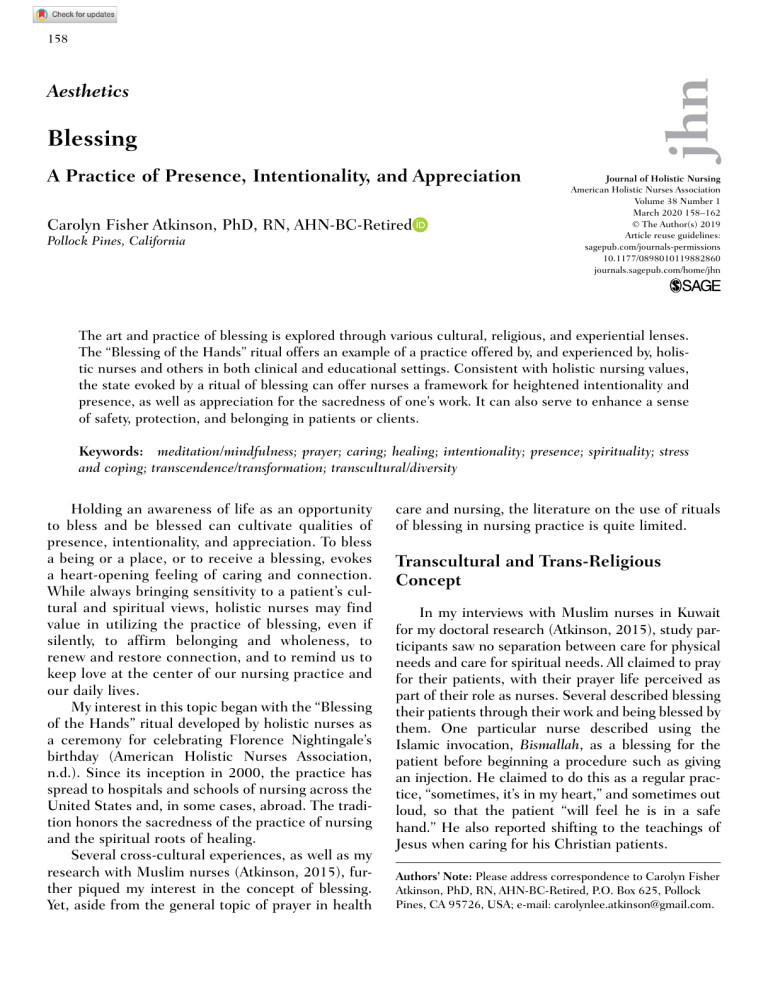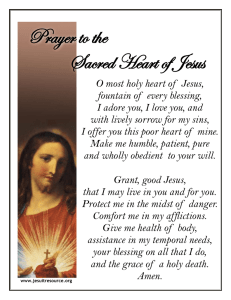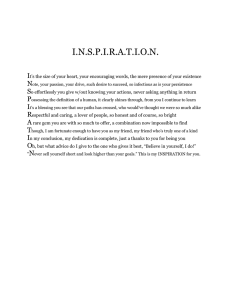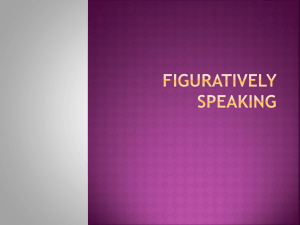
882860 JHNXXX10.1177/0898010119882860Journal of Holistic NursingBlessing Practice / Atkinson 158 jhn research-article2019 Aesthetics Blessing A Practice of Presence, Intentionality, and Appreciation Carolyn Fisher Atkinson, PhD, RN, AHN-BC-Retired Pollock Pines, California Journal of Holistic Nursing American Holistic Nurses Association Volume 38 Number 1 March 2020 158­–162 © The Author(s) 2019 Article reuse guidelines: sagepub.com/journals-permissions 10.1177/0898010119882860 journals.sagepub.com/home/jhn The art and practice of blessing is explored through various cultural, religious, and experiential lenses. The “Blessing of the Hands” ritual offers an example of a practice offered by, and experienced by, holistic nurses and others in both clinical and educational settings. Consistent with holistic nursing values, the state evoked by a ritual of blessing can offer nurses a framework for heightened intentionality and presence, as well as appreciation for the sacredness of one’s work. It can also serve to enhance a sense of safety, protection, and belonging in patients or clients. Keywords: meditation/mindfulness; prayer; caring; healing; intentionality; presence; spirituality; stress and coping; transcendence/transformation; transcultural/diversity Holding an awareness of life as an opportunity to bless and be blessed can cultivate qualities of presence, intentionality, and appreciation. To bless a being or a place, or to receive a blessing, evokes a heart-opening feeling of caring and connection. While always bringing sensitivity to a patient’s cultural and spiritual views, holistic nurses may find value in utilizing the practice of blessing, even if silently, to affirm belonging and wholeness, to renew and restore connection, and to remind us to keep love at the center of our nursing practice and our daily lives. My interest in this topic began with the “Blessing of the Hands” ritual developed by holistic nurses as a ceremony for celebrating Florence Nightingale’s birthday (American Holistic Nurses Association, n.d.). Since its inception in 2000, the practice has spread to hospitals and schools of nursing across the United States and, in some cases, abroad. The tradition honors the sacredness of the practice of nursing and the spiritual roots of healing. Several cross-cultural experiences, as well as my research with Muslim nurses (Atkinson, 2015), further piqued my interest in the concept of blessing. Yet, aside from the general topic of prayer in health care and nursing, the literature on the use of rituals of blessing in nursing practice is quite limited. Transcultural and Trans-Religious Concept In my interviews with Muslim nurses in Kuwait for my doctoral research (Atkinson, 2015), study participants saw no separation between care for physical needs and care for spiritual needs. All claimed to pray for their patients, with their prayer life perceived as part of their role as nurses. Several described blessing their patients through their work and being blessed by them. One particular nurse described using the Islamic invocation, Bismallah, as a blessing for the patient before beginning a procedure such as giving an injection. He claimed to do this as a regular practice, “sometimes, it’s in my heart,” and sometimes out loud, so that the patient “will feel he is in a safe hand.” He also reported shifting to the teachings of Jesus when caring for his Christian patients. Authors’ Note: Please address correspondence to Carolyn Fisher Atkinson, PhD, RN, AHN-BC-Retired, P.O. Box 625, Pollock Pines, CA 95726, USA; e-mail: carolynlee.atkinson@gmail.com. Blessing Practice / Atkinson 159 As a holistic nurse, I was particularly intrigued by this level of mindful presence and intentionality. The idea that such a simple gesture could offer a feeling of safety in a vulnerable situation led me to explore the notion of blessing in more depth. I discovered that the concept of blessing has a universality that transcends religion, culture, and even theism. I was reminded of an example of blessing I witnessed in China during a tour for holistic nurses in 2004. We were visiting a large Buddhist temple on a festival day. Many families with picnics were spending the day on the temple grounds while long lines of devotees filed past the statues of Buddha and Kwan Yin, making offerings of food as well as prayers. At one point a priest came to bless the offerings, dipping a leafy branch into a bowl of water and shaking water droplets onto the offerings. Seemingly as an afterthought, he turned and sprinkled water on a few people near the altar. Suddenly, everyone nearby clamored to receive a blessing. The desire to feel divinely protected was palpable. Nevertheless, the priest, apparently overwhelmed by what he had started, shook his head, waved people away, and retreated. Another example of a cross-cultural understanding of the concept of blessing came from my experience sharing the “Blessing of the Hands” ritual at the 3rd annual conference of Middle Eastern Nurses and Partners (Watson Caring Science Institute, 2015). At the conclusion of my presentation, participants were invited to pair with another in a mutual practice of hand blessing. Palestinian, Israeli, Iranian, Jordanian, Saudi, Filipino, and American nurses blessed one another, and in so doing, they shared a moment of what Jean Watson described as “falling in love with one another.” Fundamental Need for Safety and Belonging The need to feel safe is a fundamental human need, second only to physiological requirements for life (Maslow, 1943). Yet modern secular life is often devoid of the rituals, generally associated with religion, which offer comfort and a feeling of divine protection. A 2017 Pew Research Center survey of Americans demonstrated a steady decline in religious affiliation and a rise in numbers of “spiritual but not religious” between 2012 and 2017 (19% to 27%), with a corresponding fall in the number of those identifying as “religious and spiritual” (59% to 48%; Pew Research Center, 2017). How do we reclaim the comfort and meaning of religious rituals for a growing population of patients/clients who hunger for those things but who have lost the framework within which they were previously found? Rachel Naomi Remen (2010), a physician and author, has written about her experience of being blessed by her grandfather, a rabbi and storyteller. In his telling of the creation story to 4-year-old Rachel, it is the job of the human race to discover the hidden wholeness in all of life’s events, to heal the world back into its original unity. You do this, he told her, by becoming a blessing and blessing the life around you. She understood the concept of blessing because, on the Sabbath, he would put his hands on top of her head and tell God something good about Rachel. About that experience she says, “These few moments were the only time in my week when I felt safe and at rest” (p. 126). Safe and at rest—something all of us want and need to feel, especially in these troubled times. “Befriending the hidden wholeness in the world is a way of life,” Remen (2010) goes on to say (p. 128). Through the act of blessing, we discover who we are in a deeper way and affirm our (and another’s) fundamental belonging. We begin to dissolve barriers between us and another person, between us and the sacred, creating renewed flow of love and connection in a world filled with struggle and angst. “The art of blessing becomes a mode of service, a spiritual practice, and a participation in what the Western mystical alchemical tradition termed the Great Work” (Spangler, 2001, p. 68). What Is a Blessing? Throughout human history, words of blessing have been spoken across cultures and religions, over people, nations, weather conditions, objects, and events. There seems to be an innate understanding of the idea and meaning of “blessing” that even a 4-year-old, such as Rachel Remen, can intuit and feel. While the ritual of blessing can be used with superficiality and rote, within the context of a caring relationship it generally evokes a deepening of that relationship and a greater sense of reverence, connectedness, and meaning. David Spangler (2001) reminds us that the distinction between an act of kindness and offering a blessing may be the depth of sharing of spirit. As a form of communion, the act of blessing carries a reciprocity and 160 Journal of Holistic Nursing / Vol. 38, No. 1, March 2020 cannot come from a superficial or judgmental place. When “blessing” becomes a synonym for anything that makes us happy or prosperous, no matter how trivial, it undermines its ability to vitalize a spiritual power within us. In addition, it fails to appreciate that not all blessings come from pleasant circumstances. For modern Westerners, a blessing might seem like an offhand response to a sneeze, but from the Judeo-Christian perspective, it is a primary form of interaction between God and humans. Biblical scholar Ellen Davis (2019) defines blessing as “fundamentally an act of acknowledging the essential goodness of the other’s being. It is a commitment of one’s will to the flourishing of the other” (p. 28). Her work demonstrates that the concept of blessing is core to the creation story in Genesis. Accordingly, in her perspective, the story of Israel’s first ancestors reads like a primer on the complex dynamics of blessing. Unlike the popular opinion in our time, blessing in this sense does not descend from on high but actively involves humans in transmitting divine blessings from one generation to another. Author and poet John O’Donohue (2008) describes a blessing as a circle of light drawn around a person to protect, heal, and strengthen. Life is a constant flow of emergence. The beauty of blessing is its belief that it can affect what unfolds. . . . A blessing awakens future wholeness. We use the word foreshadow for something that is yet to come. We could say that a blessing “forebrightens” the way. (p. 198) The language of blessing is an invocation, a calling forth, which is the reason for the use of the word may. May you be healed. The word may carries a quality of beneficence, humility, nonjudgment of outcome. The rest of the sentence declares intention, affirming a shared vision, and remembrance of wholeness (Spangler, 2001). Blessing Rituals in Clinical and Educational Settings The idea of enlarging the field of possibility related to rituals and attitudes of blessing beyond a strictly religious context is challenging when we hold religion and secularism in duality. Yet our one heart is neither religious nor secular; it is whole and holy in its intention for compassionate caring. From that one caring heart, a blessing can set into motion the forces of resonance, attunement, and wholeness that heighten the flow of energy around a patient and prepare the way for healing work (Spangler, 2001). Wyoming Medical Center describes their semiannual nondenominational “Blessing of the Hands” ceremony as a “cherished hospital tradition” (Bleizeffer, 2014). In this and most medical centers offering the ceremony, hospital chaplains perform the ritual, which includes anointing hands with oil. However, at the Huntsman Cancer Institute (Green, 2018), a shaman, a Buddhist priest, as well as clergy from other faiths are included in the ritual process, using their traditional blessing methods. Not all hand blessing ceremonies are directed toward health care professionals. At Ohio’s Midwest Hospice, nursing home residents participate in the ritual in order to reinforce the idea that we are all caregivers for one another. A web article (Midwest Hospice, 2017) about the experience suggests that in addition to bringing the community together and fostering unity, the practice benefits attendees by giving them a sense of purpose. A cornerstone of holistic nursing practice is assisting clients and patients in finding meaning in their experience (American Holistic Nurses Association & American Nurses Association, 2007). A ritual of blessing is one way to contribute to that process. For example, a Jewish ritual website describes a blessing ceremony of bone marrow before transplantation (Paul, n.d.). This ritual includes acknowledgement of the recipient’s uncertainty, the experience of facing mortality, and the hope and intention of medical success. Guided imagery is used in the process, envisioning the marrow cells as pure healing light, warm, bright, and gentle, traveling to all areas needing healing. Through Cleveland Clinic’s Center for Spiritual Care, patients about to receive a bone marrow transplant are offered the opportunity to participate in a ritual of blessing of the bone marrow before the transplantation procedure. The program, described in an American Holistic Nurses Association 2017 Conference Poster (Van Gunten, Umosen, & Picciano, 2017), includes assessment by both a nurse and a chaplain. The patient is included as part of the interdisciplinary team creating a “new life blessing” tailored to his or her specific preferences, concerns, cultural and spiritual values, beliefs, and focus. According to one author, the team has noticed improved outcomes for patients who choose to engage in a ritual. Blessing Practice / Atkinson 161 Not all blessing rituals focus on people. Maitland, Brazil, and James-Abra (2012) describe the value of doing a formal room blessing ritual after a patient death in a long-term care facility. Staff, residents, and family all benefitted from the opportunity for closure, for acknowledging grief, for sharing stories, and bridging the gap between the deceased patient and being able to welcome a new patient to the room. Holistic nurse and aromatherapist Linda Smith (2008) describes creating sacred space for healing, prior to a client’s arrival, by offering a blessing related to one’s healing purpose. Smith also likes to add essential oils to a diffuser or the linens, noting that some healers also bless water and sprinkle or spray throughout the room. In addition, she describes a process of “blessing the senses,” an ancient ritual of anointing the hands, feet, and senses of the sick. The idea of “creating sacred space” applies both to one’s inner being and to one’s environment (Burkhardt & Nagai-Jacobson, 2002, p. 327). To offer a blessing serves both. Whether offered as a simple prayer of invocation or as part of a more elaborate ritual, it creates a pause in our busyness, focuses our attention and intention, and affirms wholeness. Very shortly after the birth of my sixth grandchild, while I (the former maternity nurse) was preoccupied with aspects of physical care for my daughter, it was the child’s other grandmother who quietly asked, “Shall we offer blessings for the baby?” “Yes! Of course, let us bless the baby.” That wise grandma, a devout Catholic, knew that her son and daughter -in-law would likely not be christening the child in her church, yet she also knew in her heart that the blessing process is not dependent on a priest. Despite our different religious heritages, it felt quite appropriate in our role as grandmothers to bless the precious newborn. At the conclusion of each course I taught on doctoral writing, I offered a blessing ritual for the students during which they stated their needs and desires for the process of completing their dissertations and offering their work to the world. The coteacher and I then offered those words (paraphrased) back to the student as a blessing. Each member of the class rested a hand on the student who received the blessing, in order to amplify the intention and connection. For several years afterward, I continued to hear from students about the significant impact and meaning of that experience. Some schools of nursing have adopted the “Blessing of the Hands” ritual for incoming students, reminiscent of the “white coat” ceremony for medical students, though perhaps with a more spiritual focus (Sacred Heart University, 2019). Others conduct the ceremony before the beginning of clinical rotations, with nursing faculty anointing the students’ hands (Norton, 2019). Living Life as a Blessing For me, the concept of blessing provides a framework, a kind of shorthand, for remembering wholeness—in myself, my neighbors and family, in our world. The practice cultivates a state of mindfulness and caring, with intentionality and gratitude. Especially in these times of deep political divide, climate emergency, and unraveling of social fabric, the practice of affirming wholeness and goodness through blessing helps me stay present in the face of despair and appreciate the moment. As Rev. Dr. Rebecca Parker (n.d.) has written, our critical work in these times is to “choose to bless the world.” Simple practices of blessing in my life have been meaningful in creating moments of sacred space. Before pressing the “send” button on an e-mail of significance and/or emotional complexity, I pause, turn my palms toward the screen, and bless the communication, setting an intention for the highest good. I find myself seeking the language of blessing, using the word may as the beneficent “calling forth” described by Spangler (2001), when writing birthday or graduation cards, when sending a text of encouragement, and when seeking to transcend my reactive response to news articles. May all be well. The following story, in my hearing of it, speaks to an act of self-blessing. A traditional Saudi Arabian man, remembering the teachings of his grandfather, said, When you are sick, you should take a bowl of water and you should read to it. If you know the Koran, read the Koran. But it doesn’t really matter what you read, so long as it is something that has real meaning to you. Then, you take the water and wash yourself with it, and you will get well. (Senge, Scharmer, Jeworski, & Flowers, 2004, p. 247) The experience of blessing can focus inwardly, as described above, or outwardly. Poet Galway Kinnell’s (2002) beautiful poem, St. Francis and the Sow, speaks evocatively to both, suggesting that “everything flowers, from within, of self-blessing.” Yet sometimes 162 Journal of Holistic Nursing / Vol. 38, No. 1, March 2020 we need to remind a being of its beauty and divinity, remind of that ability to flower from self-blessing, by placing a hand on its brow with love. Perhaps envisioning the hands of saints or shamans, loving parents or teachers, resting on our brow in an act of blessing allows us to bring into our awareness the flow of divine light and love that is ever present, always flowing through and around us. Perhaps the hands of a nurse, engaged in caring for a patient as an act of blessing, is manifesting new light in the world, reminiscent of nursing’s foremother, “The lady with the lamp.” Perhaps our hurting world is remembered into wholeness, one blessing at a time. ORCID iD Carolyn Fisher Atkinson 6434 https://orcid.org/0000-0002-4195- References American Holistic Nurses Association. (n.d.). National nurses week. Retrieved from https://www.nursingworld.org /education-events/national-nurses-week/ American Holistic Nurses Association & American Nurses Association. (2007). Holistic nursing: Scope and standards of practice. Silver Springs, MD: Author. Atkinson, C. (2015). Islamic values and nursing practice in Kuwait. Journal of Holistic Nursing, 33, 195-204. Bleizeffer, K. (2014). Blessing of the Hands. Retrieved from https://wyomingmedicalcenter.org/pulse/blessing-of-thehands-non-denominational-ceremony-is-a-cherishedhospital-t Burkhardt, M. A., & Nagai-Jacobson, M. G. (2002). Spirituality: Living our connectedness. Albany, NY: Delmar Thomson Learning. Davis, E. F. (2019). Opening Israels’ scripture. New York, NY: Oxford University Press. Green, R. (2018). Faith leaders offer nurses Blessing of the Hands at Huntsman Cancer Hospital. Retrieved from https:// fox13now.com/2018/05/11/faith-leaders-offer-nurses -blessing-of-the-hands-at-huntsman-cancer-hospital/ Kinnell, G. (2002). St. Francis and the Sow. In R. Housden (Ed.), Ten poems to open your heart (pp. 35-36). New York, NY: Harmony Books. Maitland, J. E., Brazil, K., & James-Abra, B. (2012). “They don’t just disappear”: Acknowledging death in the long-term care setting. Palliative & Supportive Care, 10, 241-247. Maslow, A. (1943). A theory of motivation. Eastford, CN: Martino Fine Books. Midwest Hospice. (2017). Blessing of the Hands. Retrieved from http://midwest-hospice.com/blessing-of-the-hands/ Norton, K. (2019). Nursing students blessed before first clinical. Retrieved from https://www.anselm.edu/news/blessing -of-the-hands-2019 O’Donohue, J. (2008). To bless the space between us. New York, NY: Doubleday. Parker, R. (n.d.). Choose to bless the world. Retrieved from https://www.uua.org/worship/words/blessing/choose-bless -world Paul, H. (n.d.). Ceremony for receiving a bone marrow transplant. Retrieved from https://www.ritualwell.org/ritual/ceremony -receiving-bone-marrow-transplant Pew Research Center. (2017). Fact tank: News in the numbers. Retrieved from https://www.pewresearch.org/fact-tank /2017/09/06/more-americans-now-say-theyre-spiritual-but -not-religious/ Remen, R. N. (2010). Becoming a blessing: Living as if your life makes a difference. In N. Simons (Ed.), Moonrise: The power of women leading from the heart (pp. 124-132). Rochester, VT: Park Street Press. Sacred Heart University. (2019). Blessing of the Hands. Retrieved from https://www.sacredheart.edu/academics /collegeofnursing/blessingofthehands/ Senge, P., Scharmer, C. O., Jeworski, J., & Flowers, B. S. (2004). Presence: An exploration of profound change in people, organizations, and society. New York, NY: Random House. Smith, L. (2008). Healing oils, healing hands: Discovering the power of prayer, hands on healing, and anointing. Arvada, CO: HTSM Press. Spangler, D. (2001). Blessing: The art and the practice. New York, NY: Riverhead Books. Van Gunten, M., Umosen, I., & Picciano, B. (2017, June). We bless new life! AHNA Annual Conference Poster Session, Palm Springs, CA. Watson Caring Science Institute. (2015, February 19-21). Human Caring in a Time of World Crisis: Transcending Culture and Boundaries. Retrieved from https://www.watsoncaringscience. org/wp-content/uploads/2015/04/Jordan-Program-2015.pdf Carolyn Fisher Atkinson, PhD, RN, AHN-BC-Retired, currently facilitates online circles of reflection for deep adaptation to the climate emergency. Over her career, she has lived and worked in four states and two foreign countries, in varying roles including maternity nurse, Healing Touch practitioner, health coach, and holistic educator. She has previously presented or published on topics such as transcultural nursing, holistic ­nursing, yoga and qigong.




